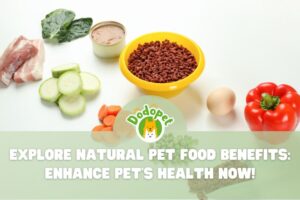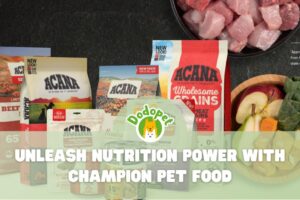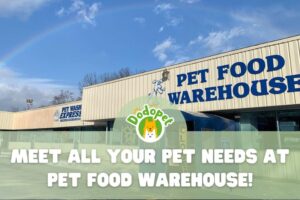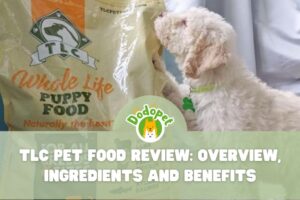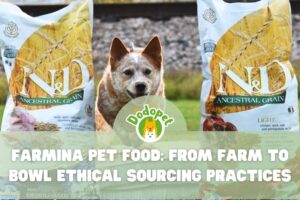When conversing with pet owners, they could show the immense enthusiasm they possess for choosing the pet food. They hold a deep attachment to the pet food preferences they’ve embraced, including preparing meals at home, opting for raw meat regimens, selecting treats and supplements, and so on. This article will solve all of the problems that pet owners could meet when struggling in choosing pet food for your beloved pet.
5 main types of pet food leading the market
Choosing the right pet food can be hard for pet owners due to the array of options available. Many are unaware of the five main types of pet food which are dry pet foods, wet pet foods, semi-moist pet foods, vegetarian/vegan pet foods, and snacks. This knowledge empowers pet owners to make informed decisions for their pets’ dietary needs.
Dry Pet Foods
Dry pet food stands as a part of the diverse selection of nourishing pet dietary choices accessible. Within dry pet foods, the moisture content ranges from 6% to 10%, constituting 90% or more dry matter (DM). This classification encompasses baked kibbles, biscuits, meals, and expanded (extruded) items. After the kibble is created, it is subsequently subjected to a drying process to eliminate any residual moisture.
Advantages of Dry Pet Foods:
- Dry pet food is easy to store, handle, and serve. It has a longer shelf life compared to wet or fresh options, making it more convenient for busy pet owners.
- The crunchy texture of dry kibble can help promote better dental health by reducing tartar buildup and promoting chewing, and contribute to healthier teeth and gums.
- Dry pet food tends to be more cost-effective than wet or specialised diets, making it a practical choice for those on a budget.
- Properly formulated dry pet foods can retain nutrients through the manufacturing process, providing a well-balanced diet for pets.
Disadvantages of Dry Pet Foods:
- Dry food contains less moisture than wet food, which might not be suitable for pets that struggle with hydration.
- Lower-quality options might contain fillers, artificial additives, and lower protein content, potentially leading to inadequate nutrition.
- Some pets, especially those with dental issues or certain health conditions, might find it harder to digest dry kibble compared to wet food.
- Dry pet foods can contain common allergens (grains or certain proteins), which could trigger allergies or sensitivities in some pets.
- The high-temperature processing can lead to a loss of certain nutrients and enzymes that are beneficial for pets.
Wet Pet Foods
Two main categories exist within wet pet food—those designed to offer comprehensive and balanced nourishment and those crafted as dietary supplements or treats, typically presented as canned or pouched meats or meat byproducts. Wet foods that are complete and balanced might incorporate a combination of components like lean meats, poultry or fish extracts, cereal grains, texturized vegetable protein (TVP), and essential vitamins and minerals.
Advantages of Wet Pet Food:
- Wet pet food contains a significant amount of water, aiding in hydration, especially for pets that don’t drink enough water on their own.
- Many pets find wet food more appealing due to its texture, aroma, and flavors, making it ideal for picky eaters or pets with dental issues.
- Wet food often offers a wider range of ingredients, including real meat and vegetables, contributing to a diverse nutritional profile.
- It’s a suitable option for pets with dental problems or smaller jaws, as the softer texture is easier to chew and swallow.
Disadvantages of Wet Pet Food:
- Once opened, wet food needs to be consumed within a relatively short period or refrigerated to prevent spoilage.
- Wet food can be more expensive per serving compared to dry food, which might strain budgets for pet owners with multiple pets or larger animals.
- Cans and pouches are bulkier and less convenient for storage and travel compared to dry kibble.
- The soft consistency of wet food might not provide the same level of dental benefits as dry kibble, potentially leading to dental issues over time.
Semimoist Pet Foods
Semimoist pet foods exhibit a water content ranging from 15% to 30%, comprising primary ingredients such as fresh or frozen animal tissues, cereal grains, fats, and simple sugars. Notably softer than dry pet foods, their texture enhances appeal and taste for certain animals. Employing diverse preservation techniques safeguards against contamination and spoilage, enabling extended shelf-life for these products.
Advantages of Semimoist Pet Foods
- Semi-moist pet food is often more appealing to pets due to its texture and flavor, making it a good choice for picky eaters.
- It’s convenient for pet owners as it doesn’t require refrigeration like wet food and doesn’t create the mess associated with dry kibble.
- Semi-moist food has a higher moisture content compared to dry kibble, which can contribute to better hydration in pets.
- It generally has a longer shelf life compared to wet food, allowing it to remain fresh for longer periods.
Disadvantages of Semimoist Pet Foods
- Semi-moist pet food often contains higher levels of sugars, artificial colors, and flavor enhancers. This can potentially lead to imbalances in a pet’s diet and contribute to obesity.
- The chewy texture of semi-moist food may not provide the same dental benefits as crunchier dry kibble, potentially leading to dental issues if not supplemented with appropriate dental care.
- Semi-moist pet food is usually more expensive than dry kibble and even some types of wet food, making it less cost-effective for pet owners.
- The packaging used for semi-moist food is often less environmentally friendly than other types of pet food, contributing to plastic waste.
Vegetarian and Vegan Pet Foods
Customers have a variety of choices available to them when picking out nourishment for their pets. These options encompass wet, fresh, or dry foods that offer comprehensive and well-rounded nutrition, along with the vital nutrients necessary for the well-being of dogs and cats in their particular life phases. It’s feasible for vegetarian or vegan dog food formulations to offer full and balanced nourishment suitable for healthy adult dogs, all without incorporating ingredients derived from animals.
Advantages of Vegetarian and Vegan Pet Foods
- Vegetarian and vegan pet food aligns with the ethical beliefs of pet owners who choose not to support animal agriculture and want to reduce their pets’ impact on animal suffering.
- Plant-based pet diets have a lower environmental footprint compared to diets that rely on animal products, contributing to reduced greenhouse gas emissions and resource consumption.
- Some pets have allergies or sensitivities to animal-derived ingredients, making plant-based diets a suitable alternative to address such issues.
- Plant-based diets can be easier for some pets to digest, especially if they have trouble with certain animal proteins.
- These diets can aid in weight management due to their typically lower fat content and higher fibre content.
Disadvantages of Vegetarian and Vegan Pet Foods
- Ensuring that a vegetarian or vegan diet provides all the essential nutrients required by pets can be challenging. These diets need careful formulation to prevent deficiencies.
- Cats, for instance, require taurine, an amino acid found primarily in animal tissues. A lack of taurine can lead to severe health issues in cats.
- Animal proteins are generally considered to have a more complete amino acid profile compared to plant-based proteins.
- Some pets might have difficulty digesting plant-based ingredients, leading to gastrointestinal problems.
Snack and treats
In recent times, there has been a growing trend among pet owners towards embracing snacks and treats besides the main pet food. These treats are procured not primarily for their nutritional benefits, but rather as a means of displaying fondness and care towards their pets. The act of feeding and tending to a pet is imbued with nurturing qualities, and offering pets these “special” treats fosters the positive emotions associated with nurturing and demonstrating affection. These treats are also employed as tools for training, reinforcing desired behaviours.
Advantages of snacks and treats:
- Snacks and treats serve as a way for pet owners to express love and affection towards their pets, strengthening the bond between them.
- Treats are effective tools for training pets, rewarding and reinforcing positive behaviours, making the training process more engaging and successful.
- Providing occasional treats adds variety to a pet’s diet, making mealtime more interesting and enjoyable for them.
- Some treats are designed to promote dental health by encouraging chewing, which can help reduce plaque buildup and maintain better oral hygiene.
- Treats can keep pets occupied, particularly during times when they might feel anxious or bored.
Disadvantages of snacks and treats:
- Many commercial treats are high in calories, sugars, and fats, potentially leading to weight gain and nutritional imbalances if not properly regulated.
- Some pets might have allergies or sensitivities to certain ingredients in treats, leading to digestive issues or skin problems.
- Over-reliance on treats can sometimes lead to pets only obeying commands when treats are present, and they might become less responsive otherwise.
- High-quality treats can be expensive, and frequent use might contribute to increased pet care costs over time.
- Inappropriate treats, especially those intended for humans, can pose health risks to pets if they contain toxic substances like chocolate, raisins, or certain spices.

5 main types of pet food leading the market
What to look for in a Pet Food Producer?
When selecting a pet food product for your beloved pet, keep the following considerations. Nutritionists with product specifications and qualifications should work for a suitable pet food brand. The following are some things to think about while choosing a brand of pet food for your pet.
Is there a nutritionist?
When choosing pet food, pet owners should look for products that have either a PhD in he American College of Veterinary Nutrition (ACVN) or the European College of Veterinary Comparative Nutrition (ECVCN). You should be aware of whether or not they have a nutritionist, as well as their names, qualifications, and job status. Consultants may have less effect than a Nutritionist.
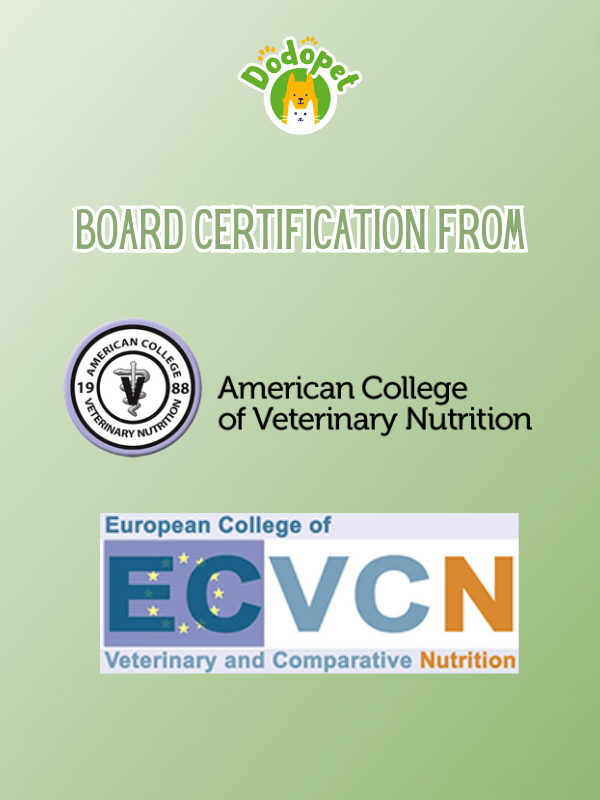
Pet owners should look for products that have either a PhD in Animal Nutrition or Board Certification
Who determines the diet?
An skilled pet food formulator (MS or PhD in Animal Nutrition) must develop the recipe in pet food. Vegetarians are not permitted to create pet food formulations since recipe development is a sophisticated process that necessitates understanding of nutrition, raw ingredients, and processing that is not taught in veterinary school programs. Formulators that are well-trained and experienced may have a degree (MS/PhD) in food science and technology to help guide ingredient selection and nutrient levels for health or disease management.
What is the method for ensuring the quality of ingredients and finished products?
Diets designed to meet the nutrient profiles of the Association of American Feed Control Officials (AAFCO) or the European Pet Food Industry Federation (FEDIAF) should do so. Does the diet meet the profile based on nutrient database analysis or chemical analysis of the completed product?
To protect the safety of companion animals and owners, manufacturers and pet food providers should have proper quality control. Prior to, during, and after manufacturing, this should include ingredient (food and supplement) validation, final diet nutrient analysis, toxicity, bacteriology, and packaging/shelf-life screens.

Method for ensuring the quality of ingredients and finished products
What to find on pet food products label
Once you choose a pet food brand, you could consider what product should an ideal pet owner buy for their best friends. There are some characteristics that you should notice about nutrition, calories per serving and how you could find help when there is a problem with the pet food you bought.
Nutrition adequacy statement
It’s important for foods to carry labels indicating whether they offer a “complete” diet containing all necessary nutrients. The label should clarify whether this determination was reached through life stage feeding trials or formulation to fulfil requirements. Products labelled for “short-term,” “intermittent,” or “complementary” feeding should constitute only a small fraction (10% or less) of the diet, unless under veterinary guidance for therapeutic purposes. This labelling approach ensures proper understanding of how these foods should be incorporated into a pet’s diet.
How many calories per gram or serving of food?
The prevalence of obesity among pets is on the rise in various parts of the world. Accurate information regarding the caloric content of pet food is crucial in preventing unintentional overfeeding. While calorie details are mandatory on pet food labels in the United States, this requirement might not apply everywhere. In cases where this information is absent on the label, it’s advisable to reach out to the manufacturer for clarification or calculate the caloric content using the nutrient analysis provided on the label. This proactive approach can greatly assist in maintaining pets’ healthy weight.
Does the company provide immediate contact information such as a phone number or email address?
Having accessible company representatives for addressing supplementary inquiries is essential, particularly regarding specific nutrients not listed on the label. Pet food companies should have the capability to furnish an “average” or “typical” nutrient analysis for all crucial elements present in their products. This level of transparency ensures that pet owners can make informed decisions about their pets’ nutrition and well-being.
Top Global Pet food brands
There are abundant pet food product brands on the pet food market. However, there are some high-quality and well-known pet food brands that you could refer and try to make the best decision for your pet.

Top Global Pet food brands
Mars Petcare
Mars Petcare is a division of Mars, Incorporated, one of the largest food manufacturers in the world. They offer a wide range of pet food products and pet care services.
- Popular Brands: Pedigree, Whiskas, Royal Canin, Iams, and Nutro.
- Focus: They emphasize research and innovation to create balanced and nutritious pet food options tailored to the specific needs of different pets.
Nestle’ Purina PetCare
Nestlé Purina PetCare is a subsidiary of Nestlé, one of the largest food and beverage companies globally. They are dedicated to producing high-quality pet foods and treats.
- Popular Brands: Well-known brands under Nestlé Purina PetCare include Purina ONE, Purina Pro Plan, Fancy Feast, and Friskies.
- Focus: Their emphasis is on science-based nutrition, and they perform significant research to ensure that their products match the nutritional needs of pets.
Hill’s Pet Nutrition
Overview: Hill’s Pet Nutrition is a subsidiary of Colgate-Palmolive Company. They specialize in prescription and science-based pet foods.
- Popular Brands: Hill’s Science Diet and Hill’s Prescription Diet are among their notable brands.
- Focus: Hill’s emphasizes veterinary collaboration and offers a range of diets formulated for specific health conditions.
J.M. Smucker
Overview: J.M. Smucker is a well-known company that produces a variety of food products, including pet food.
- Popular Brands: Smucker’s pet food brands include Meow Mix, Milk-Bone, 9Lives.
- Focus: They focus on diversity of the pet food, offer a range of products catering to different preferences and needs, from dry kibble to treats.



